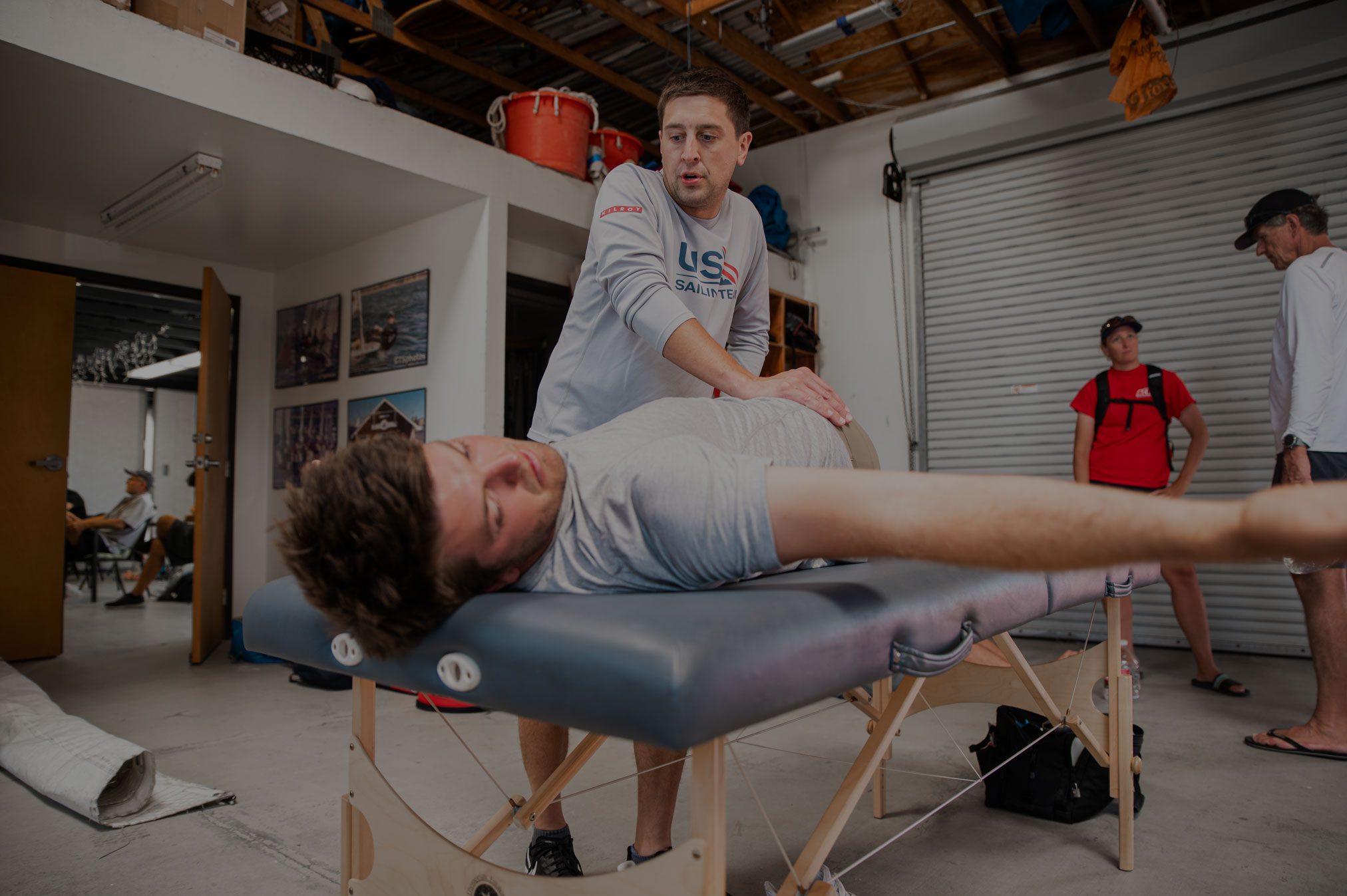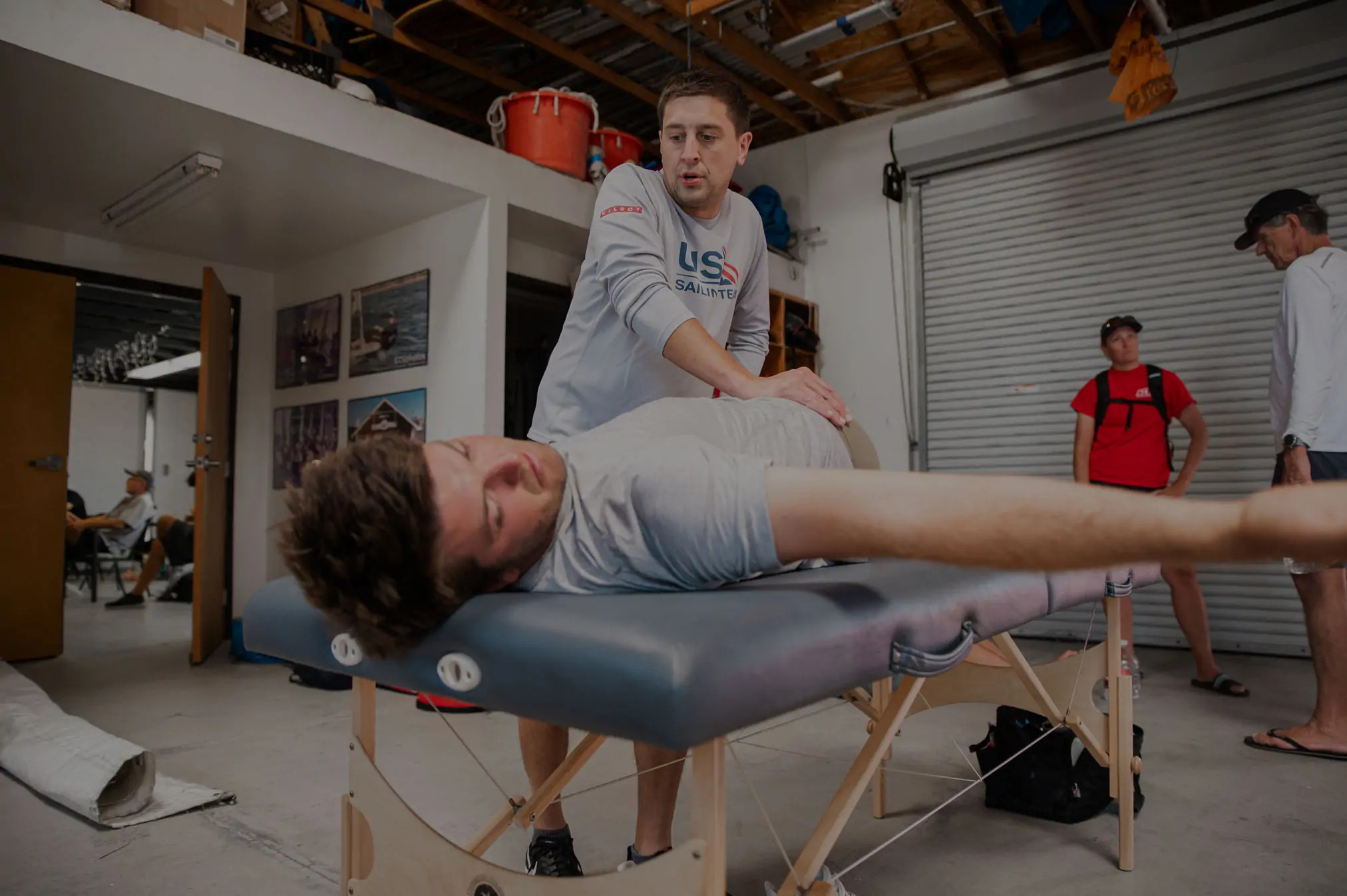Get to know a few members of the behind-the-scenes team that supports Olympic Class athletes. From their prestigious backgrounds to their goals in Marseille see what their position entails, and how they work to support the dreams of the US Sailing Team.
Dr. Chris Ellis, US Sailing Team Director of Medical Operations.
Dr. Chris Ellis has been the Director of Medical Operations for the US Sailing Team since 2016 and has 15 years of experience as a Physical Therapist specializing in Athletic Training and Strength and Conditioning. He works in sport performance rehab for elite athletes in the NFL, NHL, MLB, NBA, Tennis and Golf spheres in addition to Sailing, and holds ATC and DPT degrees from Canisius College and the University of Miami, respectively.
What is your role with the USST
I’m currently the Medical Director and Head Physical Therapist for the USST. I oversee all team medical operations and act as the lead medical contact for all our athletes. I ensure all athletes get elite, efficient, and effective medical care in a timely manner. The health and safety of all our athletes is my top priority.
How long have you worked with the team?
I first started working with the team in 2012 prior to the London Olympic Games as a staff therapist. After London, I covered many sailing events all over the world, including World Cups and Championships. In 2016, I was promoted to Head Physical Therapist and Medical Director to oversee all medical services for the Rio Olympics. Following Rio, I focused on the development of a multidisciplinary team to provide top quality medical services to lead our team into the 2020 Tokyo Olympics. As acting Medical Director, I will continue to pursue medical excellence for our Team.
What are the main focuses in 2022 for your position, and what goals do you have leading up to Marseille?
Continue to provide a high quality medical and fitness program.
Commitment to full development of all athletes so they can achieve the highest level of physical, technical, and mental strength on the water.
Provide athletes with a network of elite providers for medical and fitness coverage.
What technology do you use in your role (if applicable)? And how does it impact the athletes?
We use fitness tracking devices to monitor athletes’ activity workloads. Our team uses a wide variety of devices to monitor athlete recovery, body strain, sleep and overall health 24/7. These devices help us prevent injuries and improve performance.
What does a typical day in the life look like for you?
When I’m not traveling with the USST, I’m directing and managing my company, Force Physical Therapy. I specialize in sports rehabilitation and treat many professional athletes in the South Florida area.
What is your favorite Gill product?
Any UV Tec gear

Dr. Riley Schutt, USST Head of Technology
Riley Schutt is the US Sailing Team Head of Technology. Riley has Aerospace Engineering degrees from MIT and Cornell University, including a PhD studying the Unsteady Aerodynamics of Sailing. He has pursued a career in the performance modeling and design of racing yachts and sits on the editorial board of the Journal of Sailing Technology. Before joining USST in 2017, Riley worked as a designer in the America’s Cup, Volvo Ocean Race, Vendee Globe, and on numerous record-breaking ocean racers. He also is a world-championship winning crew in the IOD class.
What is your role with the USST?
I am the Head of Technology at the US Sailing Team, using science, engineering, data, and math to help our sailors go faster on the racecourse
How long have you worked with the team?
5 years
What are the main focuses in 2022 for your position, and what goals do you have leading up to Marseille?
Bringing more actionable data into USST training.
What technology do you use in your role (if applicable)? And how does it impact the athletes?
This would be a really long list, but one of my favorites is writing code in Python. It lets me test new ways to analyze sailing data quickly and get information to the athletes about how they can be faster on the water.
What does a typical day in the life look like for you?
A mix of writing code, building hardware, designing parts, and working with athletes and coaches. On days when I am lucky, I get to test it on the water.
What are 2 quick tips you’d like to pass on to someone who is just learning to sail?
Learn a little bit about the science of sailing, it will help you understand how to go faster!Learn to appreciate time working on your boat. It’s a skill that will pay off both monetarily and in seconds on the racecourse.
What is your favorite Gill product?
Gill Compressor Vest

Chelsea Carlson Freas, USST Meteorologist
Chelsea is a meteorologist and lifelong sailor who has ‘tied the knot’ between the science of weather and the strategy of sailboat racing. She’s the meteorologist for the US Sailing Team and has a variety of racing experience from one-design dinghies to offshore keelboats. Through her company SeaTactics, she delivers expert weather knowledge to racers who want to elevate their sailing strategies and gain a competitive edge.
What is your role with the USST?
My role is to provide weather forecasting, coaching and education to help give the team a competitive edge while on the water.
How long have you worked with the team?
I’ve worked with the team since July 2018.
What are the main focuses in 2022 for your position, and what goals do you have leading up to Marseille?
This year, we are 2 years out from the Games, so the main goals are: research and develop playbooks for the most important venues such as the Olympic Games location in Marseille, and improve the athletes’ overall weather education, especially for those venues.
What technology do you use in your role (if applicable)? And how does it impact the athletes?
I also work closely with the technology team (Riley Schutt) to develop data-driven systems for collecting and understanding the environment at our sailing venues. We use various weather instruments on a weather pole that goes onto the coach boats to collect data on the water. We use that data to characterize the weather at various venues, as well as look at key sailing performance metrics.
What does a typical day in the life look like for you?
A typical day supporting the team onsite at a regatta begins with producing the early morning forecast from 5am to 7am. I then have a coach/team meeting including a weather briefing, before heading to the venue. Many days I spend the whole day on the water in a rib, observing the wind and weather trends and providing forecast updates, helping the team to understand what to expect on the courses. At the end of the day, I usually de-brief the team and give a preview of what to expect for the next day of racing.
I also have other responsibilities when traveling for a reconnaissance trip (focusing on repeating weather patterns), or during team training camps which are more focused on weather education.
What are 2 quick tips you’d like to pass on to someone who is just learning to sail?
Have fun – and learn about weather!!
What is your favorite Gill product?
I have a waterproof duffel bag that I’ve had for many years and has traveled around the world with me, keeping all my gear happy and safe!
Sally Barkow Head of Operations, US Olympic Sailing
Sally Barkow is a 2008 Beijing Olympian, 2x Rolex Yachtswoman of the Year, and now serves as the Head of Operations for US Olympic Sailing. Originally from Wisconsin, Barkow was a driver/trimmer for the 2014-15 Volvo Ocean Race, won the ISAF Women’s Match Racing World Championship in 2004 and 2005, and is a 3x winner of the International Women’s Keelboat Championship. On the staff side now,Sally coached the US Nacra Team in Tokyo 2020 and is currently working to organize efficient operations for Paris 2024.
What is your role with the USST?
Head of Operations for the US Sailing Team.
How long have you worked with the team?
Started officially in 2019, after a few years serving on US Sailing board of directors. Was on the USST from 2003-2012
What are the main focuses in 2022 for your position, and what goals do you have leading up to Marseille?
Mainly focused on getting the operations of the team running efficiently and well in advance. I believe if athletes have a well thought out, executed plan they can then use all their energy for training and racing.
What technology do you use in your role (if applicable)? And how does it impact the athletes?
What does a typical day in the life look like for you?
A day for me is connecting with staff and athletes to get schedules and plans across the line, being organized behind the scenes is how we are able to give more opportunities and funding to athletes.
What are 2 quick tips you’d like to pass on to someone who is just learning to sail?
Just enjoy being on the water, if your competitive, try racing its highly addictive!
What is your favorite Gill product?
I love the Penryn Hybrid jacket, perfect for a layer on the water while coaching, yet flexible to use skiing keeping your core warm and arms free.

Sally Barkow Head of Operations, US Olympic Sailing
Sally Barkow is a 2008 Beijing Olympian, 2x Rolex Yachtswoman of the Year, and now serves as the Head of Operations for US Olympic Sailing. Originally from Wisconsin, Barkow was a driver/trimmer for the 2014-15 Volvo Ocean Race, won the ISAF Women’s Match Racing World Championship in 2004 and 2005, and is a 3x winner of the International Women’s Keelboat Championship. On the staff side now,Sally coached the US Nacra Team in Tokyo 2020 and is currently working to organize efficient operations for Paris 2024.
What is your role with the USST?
Head of Operations for the US Sailing Team.
How long have you worked with the team?
Started officially in 2019, after a few years serving on US Sailing board of directors. Was on the USST from 2003-2012
What are the main focuses in 2022 for your position, and what goals do you have leading up to Marseille?
Mainly focused on getting the operations of the team running efficiently and well in advance. I believe if athletes have a well thought out, executed plan they can then use all their energy for training and racing.
What technology do you use in your role (if applicable)? And how does it impact the athletes?
What does a typical day in the life look like for you?
A day for me is connecting with staff and athletes to get schedules and plans across the line, being organized behind the scenes is how we are able to give more opportunities and funding to athletes.
What are 2 quick tips you’d like to pass on to someone who is just learning to sail?
Just enjoy being on the water, if your competitive, try racing its highly addictive!
What is your favorite Gill product?
I love the Penryn Hybrid jacket, perfect for a layer on the water while coaching, yet flexible to use skiing keeping your core warm and arms free.








